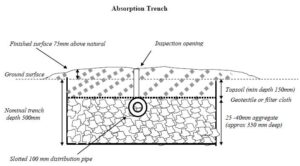There are many areas around Tasmania that are un-serviced (without council or water authority sewer and stormwater services).
For these areas all your wastewater from your toilet, kitchen, bathroom and laundry must be disposed of within your property boundaries.
It’s not generally a topic property owners get excited about but it is essential that the right system is installed for the health and safety of the occupants of your home and neighbouring properties.
New Developments
All new developments require a system to be designed in accordance with the Australian Standard AS-1547.
The basic design criteria for the system’s capacity and size are number of bedrooms and the soil type.
Wastewater systems vary from the basic septic tank and soakage trenches, for kitchen and toilet (Black Water) combined with separate soakage trenches for the bathroom and laundry (Grey Water), to the more elaborate Aerated Wastewater Treatment Systems (AWTS) and irrigation beds, which treat all the wastewater combined. There are other forms for varied situations but commonly these are the types used by the majority.
Older Existing Systems
It has only been recent years that much more science has been required to evaluate the system size and suitability for a particular site.
Previously system sizes were more standardised and it wasn’t uncommon for similar sized systems to be placed in all soil types.
In some areas the systems installed would fail due to not being adequately sized to suit both the demand and the soil type, thus exceeding the effective capacity. For example, disposal areas in a clay soil would generally require to be much larger than that in a sand soil. Evidence of a system failure is normally wastewater appearing above ground and of course the smell.
Dwelling Additions
For those planning an addition to your existing home it is now a common request from council to have the existing wastewater treatment system assessed by a suitably qualified professional. If the existing system doesn’t comply with the current standards AS-1547 and plumbing regulations the system will be required to be upgraded or replaced.
The two main reasons for council to request an assessment is if there is previous evidence of the system failing or if the additions include more bedrooms, thus increasing the number of potential occupants.
It may be that council request you to simply locate, on a plan, the position of the existing system to ensure the proposed additions don’t affect that system. Having a knowledge of your own existing wastewater system, by checking existing plumbing plans with council or simply tracing where the system is located in your yard, is valuable when planning any project.
Special Plumbing Application
With all new work, including upgrading or replacing an existing system, you are required to provide a special plumbing application in addition to any building and plumbing applications.
The design of the system and application to council will simply form part of the design documents for the proposed works.
More information.
To learn more about your specific needs and the right people to talk to go to Wastewater Design under Consultants and Wastewater Treatment under Products and Suppliers, or talk to your local council health officer.
Courtesy of Dr John Paul Cumming (GES)


I think it is a good thing that wastewater systems have to be evaluated when editions are added to homes. It just makes sense to upgrade the septic system, especially if a new bathroom or sink is being added to the home. It is just something you have to add to your budget, but on the bright side, it will be a one time expense, and you won’t have problems with waste clogging up your system.
Thanks James,
It’s true in what you say, however it is generally the addition of a bedroom or bedrooms, increasing the potential occupancy numbers in the home that will trigger the requirement of re-assessment of the waste water system.